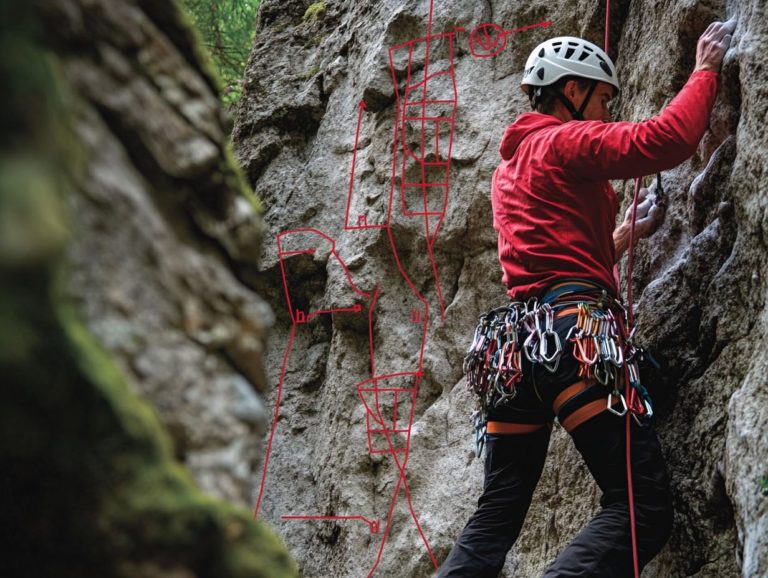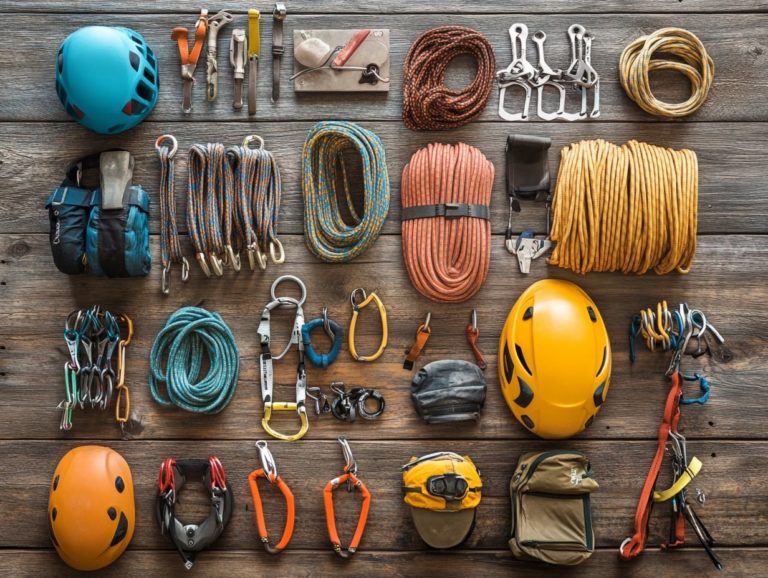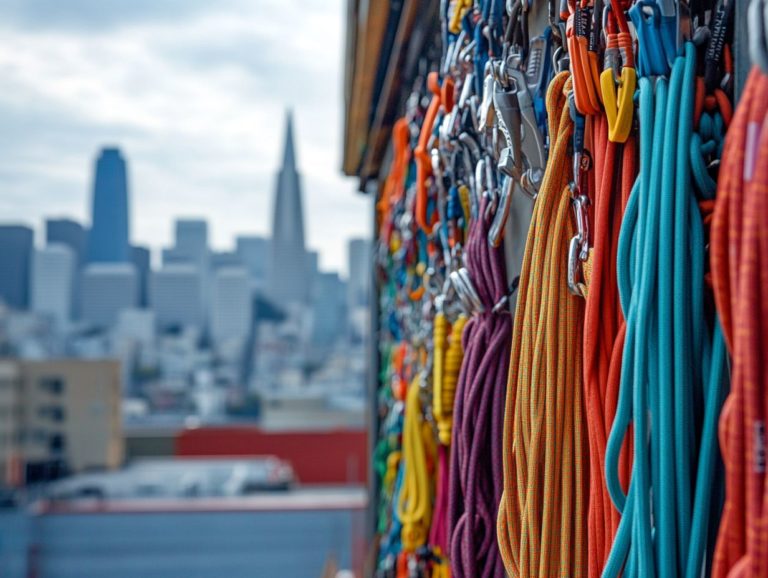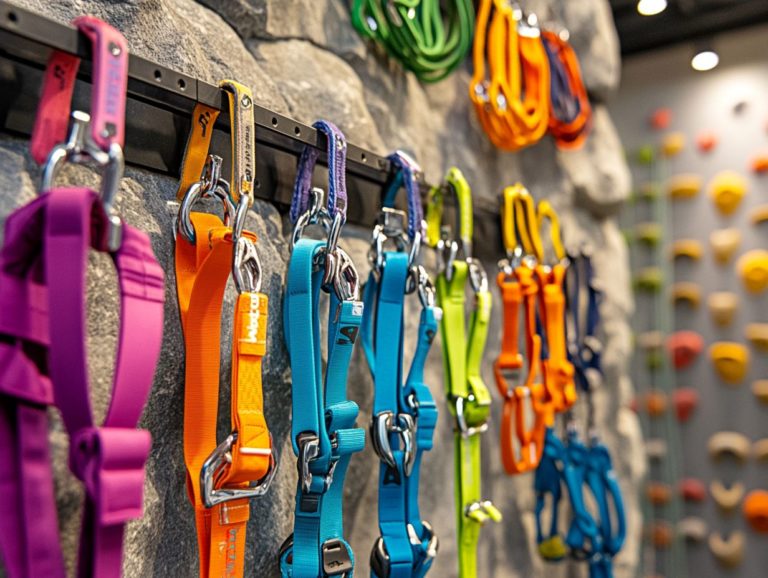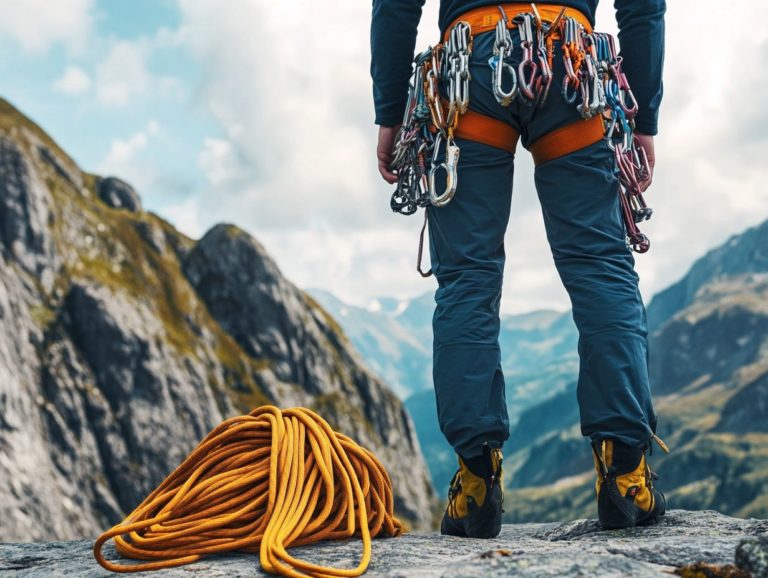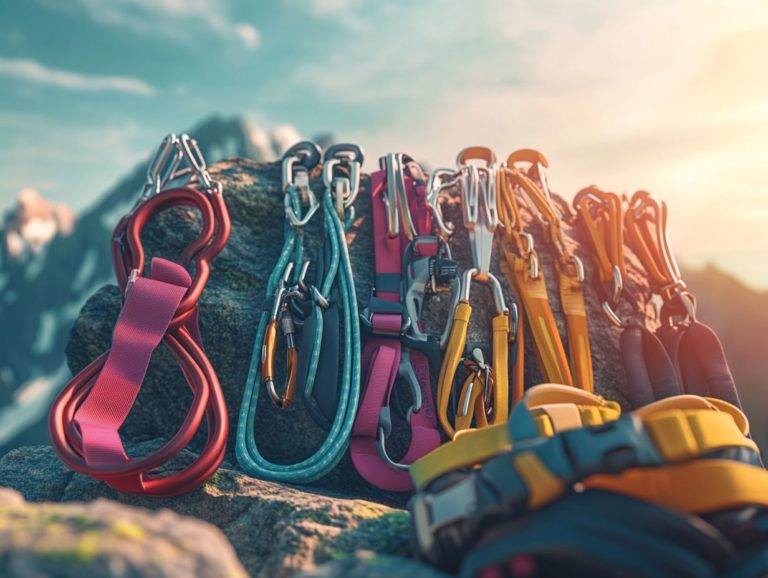5 Rock Climbing Gear Essentials You Need
Rock climbing is an exhilarating adventure, and having the right gear is absolutely vital for your safety and performance.
Whether you re just starting out or you ve already mastered the art of climbing, understanding the essentials of your equipment can significantly enhance your experience and confidence on the rock face.
This article delves into five must-have climbing gear essentials, covering everything from climbing shoes to helmets, while addressing key questions about fit, types, and maintenance.
Prepare to gear up and elevate your climbing adventures to new heights!
Contents
- Key Takeaways:
- 1. Climbing Shoes
- 2. Harness
- 3. Chalk Bag and Chalk
- 4. Belay Device
- 5. Helmet
- What Other Gear Is Recommended for Rock Climbing?
- How Important Is Proper Fit for Climbing Gear?
- What Are the Different Types of Climbing Shoes?
- What Are the Different Types of Harnesses?
- Why Is Chalk Necessary for Climbing?
- What Are the Different Types of Belay Devices?
- Why Is a Helmet Important for Rock Climbing?
- How Can One Determine the Right Gear for Their Climbing Style?
- What Are Some Common Mistakes to Avoid When Buying Climbing Gear?
- How Can One Properly Maintain Their Climbing Gear?
- What Are Some Essential Tips for Using Climbing Gear Safely?
- Frequently Asked Questions
Key Takeaways:
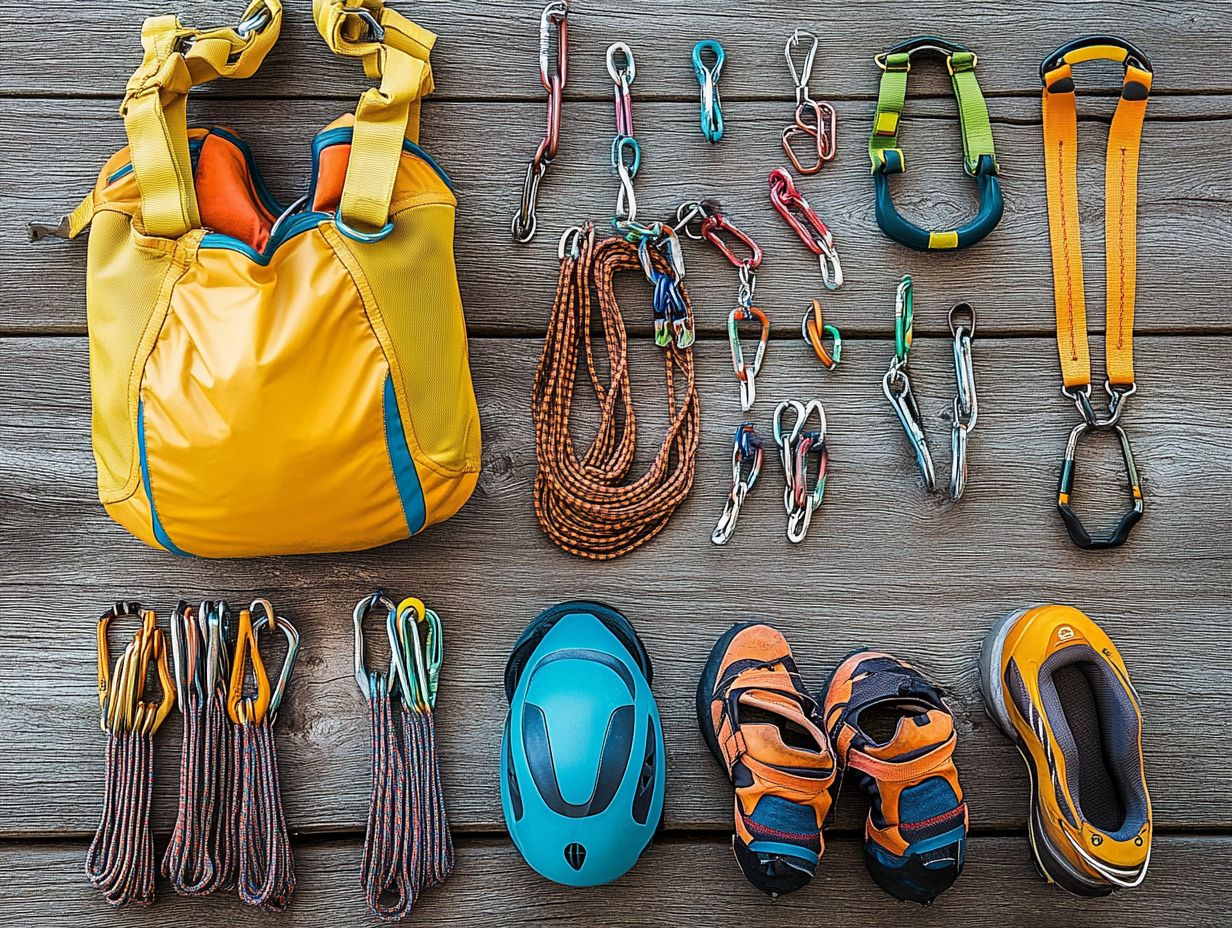
- Proper fit is crucial for all climbing gear to ensure safety and comfort.
- Different types of climbing shoes and harnesses cater to various styles and levels of climbing.
- Chalk is necessary for maintaining grip and preventing slipping while climbing.
1. Climbing Shoes
Climbing shoes are essential for your climbing arsenal, crafted specifically to boost both comfort and performance. They help you navigate various routes with enhanced grip and precision. With leading brands like La Sportiva, Five Ten, and SCARPA, the right pair of shoes can truly elevate your climbing experience, whether you re just starting out or have years of experience.
It s crucial to know how different shoe types cater to your unique climbing styles and techniques, ensuring you have the best experience outdoors.
Different types of climbing shoes have distinct features tailored to your needs. For instance, aggressive shoes often showcase a pointed toe and a snug fit for precision on small footholds, while moderate shoes offer a more relaxed fit for multipitch climbs.
Materials like synthetic fabrics and leather influence stretch and comfort, while rubber sole designs vary from sticky compounds that enhance grip to stiffer options for support on edges. The right shoe not only refines your technique but also bolsters your safety.
Renowned brands like La Sportiva offer impressive models, such as the Theory and the Tarantula. Five Ten s classic Anasazi is another dependable choice. Understanding each shoe’s unique attributes related to your climbing preferences is crucial for optimizing your performance on the rock.
2. Harness
A climbing harness is critical for your climbing gear, offering both safety and comfort during your adventures. It ensures you’re securely attached to your climbing rope and belay device.
Harnesses come in various styles tailored to specific climbing genres and environments sport, trad, and alpine each specifically designed for its purpose. Sport harnesses typically have a streamlined design that maximizes your freedom of movement, while trad harnesses often include extra gear loops for carrying protection. Alpine harnesses use lightweight materials to meet the demands of high-altitude excursions.
Selecting a harness that fits properly and offers comfort is absolutely critical, as this directly impacts your safety and overall climbing experience. Brands like Petzl, Black Diamond, and Mammut are celebrated for their high-quality products, ensuring reliability on every ascent.
3. Chalk Bag and Chalk
A chalk bag filled with climbing chalk is essential for optimizing your climbing performance. It helps you maintain a secure grip on holds and enhances your overall climbing enjoyment.
This vital accessory improves grip and helps manage moisture on your hands, which can seriously hinder your ability to hold on. Using chalk reduces sweat, allowing you to climb longer without the frustration of slipping off holds.
Different formulations of climbing chalk some with drying agents or eco-friendly options can significantly affect your ability to perform techniques like mantling (a technique where you push down on a hold to lift your body up) or dynamic moves.
Equally important is the choice of chalk bag; selecting one that fits your personal preferences be it size, material, or closure type can boost convenience and accessibility while you climb. This attention to detail leads to a more focused and enjoyable climbing experience.
Explore your climbing gear options and start your adventure today!
4. Belay Device
A belay device is an essential piece of climbing gear that elevates your safety while climbing by controlling your descent and ensuring a secure connection to the climbing rope.
Understanding the different types of belay devices is vital for anyone looking to refine their skills and enhance safety practices. The most popular options include tube, assisted-braking, and figure-eight devices.
- Tube devices: Simple but effective, they use friction to control the rope, making them a top choice for sport climbing.
- Assisted-braking devices: These add an extra layer of security by automatically locking the rope in the event of a fall, which is especially advantageous for those building their climbing confidence.
- Figure-eight devices: While versatile for rappel descents, they demand a bit more skill to handle effectively.
Each type of belay device has its own set of benefits and specific applications. Choosing the right one can profoundly impact both your safety and the fluidity of your climbing experience.
5. Helmet
A climbing helmet is a critical piece of safety gear that plays a crucial role in protecting you from falling debris and potential head injuries during your outdoor climbing adventures.
When selecting the right helmet, focus on key features that enhance your climbing experience. A lightweight construction is essential for maintaining comfort during long climbs. Effective ventilation helps keep your head cool in warmer conditions.
Durability is vital; your helmet must withstand impacts and abrasions from rugged terrains. Remember, wearing a helmet is crucial to keeping you safe and confident while climbing! It s important not just for outdoor climbing but also in indoor gyms and on multi-pitch routes, where the risk of accidents remains ever-present.
Brands such as Petzl, BD, and Mammut offer reliable helmets that adhere to strict safety standards, making them ideal options for those who prioritize both performance and protection in their climbing gear.
What Other Gear Is Recommended for Rock Climbing?
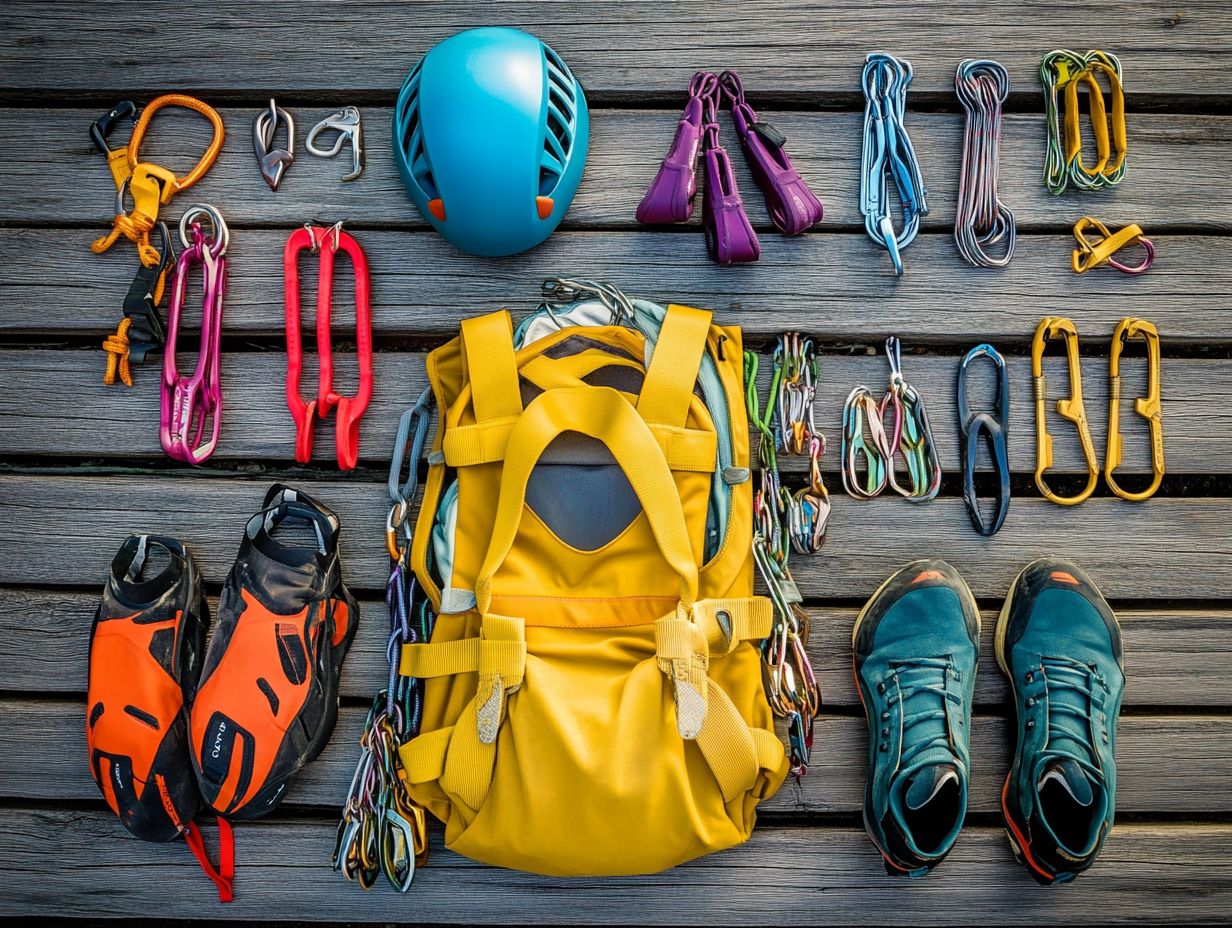
In addition to your primary climbing gear like shoes and harnesses, several other essentials can elevate both your safety and enjoyment during climbing adventures. These investments are definitely worth it for any climber.
Among these crucial accessories, quickdraws stand out. They allow you to make quick and secure connections to climbing routes, giving you peace of mind by minimizing fall distance. Climbing ropes are equally vital; choosing the right one can absorb impact during a fall, effectively shielding you from injury.
Let s not forget climbing chalk it helps you maintain a secure grip on holds, especially in humid conditions, preventing those pesky slips.
If you’re just starting out, consider gear like a basic helmet and a crash pad for bouldering. Seasoned climbers can benefit from advanced equipment, such as dynamic ropes (ropes that stretch to absorb shock) and specialized carabiners (connectors that can handle specific loads). For those looking to enhance their adventures, exploring the best climbing gear for camping adventures can significantly contribute to crafting a memorable and safe climbing experience.
How Important Is Proper Fit for Climbing Gear?
Proper fit for your climbing gear is essential for your safety and comfort. Ill-fitting equipment can hinder your climbing performance and increase the risk of injuries.
Finding equipment that feels just right can dramatically enhance your technique during ascents, allowing for better movements and boosting your overall confidence. As you select your climbing gear, particularly shoes and harnesses, prioritize a snug yet comfortable fit. For more information, check out the essential gear for indoor climbing.
Be sure to measure your foot length and width accurately, and consider the type of climbing you ll be doing, as this can significantly influence your gear choices. Always try on different brands to see how they feel; sizing can vary quite a bit.
Investing time in properly testing each piece of equipment can lead to a noticeable improvement in both performance and enjoyment on the rock face.
What Are the Different Types of Climbing Shoes?
There are various types of climbing shoes tailored to meet specific climbing styles and performance needs, from aggressive downturned shoes perfect for sport climbing to comfortable all-day shoes designed for trad climbing. Each category serves a distinct purpose, enabling you to select the ideal footwear that complements your techniques.
Aggressive shoes, characterized by pointed toes and a stiff construction, allow for precision on small footholds, making them perfect for steep routes and overhangs.
Moderate shoes provide a balanced fit, delivering an excellent mix of comfort and performance. They are well-suited for multi-pitch climbs and longer endeavors.
For beginners or those who prefer to spend extended periods climbing, neutral shoes come with a relaxed fit and ample cushioning, making them the perfect choice.
By understanding these different styles, you can choose the right shoes to boost your performance and enjoy every climb!
What Are the Different Types of Harnesses?
Climbing harnesses come in various types, each meticulously designed to meet your specific climbing needs be it sport climbing, trad climbing, or climbing longer routes with multiple pitches. This ensures your safety and comfort in a range of situations.
Different harnesses boast features that can greatly enhance your climbing experience. For example, gear loops (attachments for carrying gear) are critical for carrying your equipment, while well-padded harnesses keep you comfortable on long ascents, helping to minimize fatigue.
Adjustability is also crucial; a harness with multiple adjustment points provides a snug fit that enhances safety by reducing movement during climbs.
Reflect on the type of climbing you plan to do whether it s quick sport routes or extended multipitch expeditions to choose a harness that aligns perfectly with your activities.
Breathability, weight, and design are also essential in optimizing both your comfort and performance while climbing.
Why Is Chalk Necessary for Climbing?
Climbing chalk is essential for enhancing your grip and preventing hand sweat during climbs, elevating your performance and safety on the rock.
This critical tool employs magnesium carbonate, a compound renowned for its moisture-absorbing properties. It creates a dry, textured surface that helps you maintain a solid grip as you ascend.
As you climb, it’s natural for your palms to sweat, which can lead to slips and falls; however, the chalk effectively mitigates this issue by drawing moisture away.
Explore these chalk types to find your perfect match:
- Loose chalk: Provides maximum coverage and control.
- Chalk balls: Minimize mess and waste, which is particularly advantageous for bouldering.
- Liquid chalk: Offers unique benefits tailored to specific needs.
Understanding these options can quickly elevate your climbing skills!
What Are the Different Types of Belay Devices?
Belay devices come in various types, each meticulously crafted to enhance your climbing safety and control your descent while using climbing gear.
These devices play vital roles in different climbing scenarios, whether you re sport climbing or tackling trad and multi-pitch routes. Understanding how they function is essential for choosing the right tool for every situation.
For example, tubular devices are often preferred for their versatility and simplicity, offering reliable descent control and allowing you to adjust tension with ease.
On the other hand, assisted-braking devices (devices that automatically engage when a climber falls) provide an added layer of security, making them particularly beneficial for less experienced climbers.
The choice of a belay device significantly impacts your climbing techniques and overall safety, as each type interacts differently with rope dynamics. Selecting the appropriate device based on your climbing environment and skill level is crucial for ensuring a secure and enjoyable experience.
Why Is a Helmet Important for Rock Climbing?
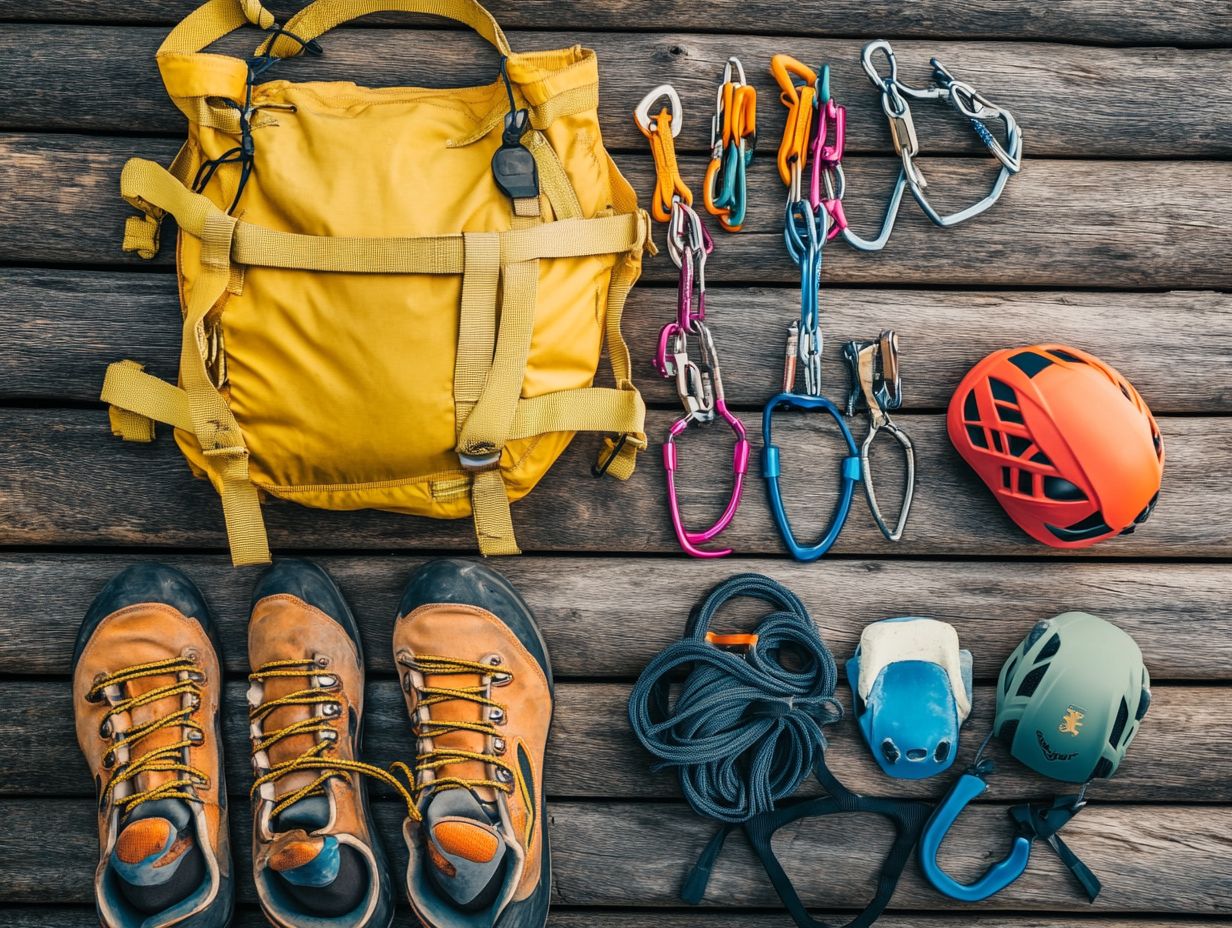
A climbing helmet is essential for protecting you from head injuries caused by falling rocks or slips. Safety is critical in outdoor climbing.
In unpredictable conditions, like loose rock faces, head protection is vital. Wearing a climbing helmet guards against overhead hazards and adds security during scrambles.
When choosing a helmet, consider weight, ventilation, and fit. A well-chosen helmet reduces risks from falls and debris, helping you focus on climbing techniques.
How Can One Determine the Right Gear for Their Climbing Style?
Choosing the right gear starts with understanding your climbing techniques and preferences. Your equipment should align with the type of climbing you do.
Reflect on your experiences to identify which styles resonate with you. Each climbing type, like bouldering or sport climbing, requires specific gear.
For instance, trad climbing involves placing removable gear. Assess your strengths and comfort in different environments to choose suitable harnesses and shoes.
What Are Some Common Mistakes to Avoid When Buying Climbing Gear?
Common mistakes in buying gear often stem from insufficient research. This can lead to equipment that doesn’t meet your climbing needs or safety standards.
Many climbers mistakenly prioritize trendy brands over functional gear, which can be a costly misstep.
To avoid these pitfalls, consider fit, functionality, and the demands of your activity. Reading reviews, seeking expert advice, and testing gear in-store can help you make better choices.
Ensure every piece of equipment elevates your climbing experience.
How Can One Properly Maintain Their Climbing Gear?
Maintaining your climbing gear is crucial for safety and longevity. Proper care can reduce the risk of accidents during climbs.
Establish a routine for cleaning, storing, and inspecting your gear. Follow the specific care instructions from manufacturers, as different materials have unique needs.
For example, wash your ropes with mild soap and dry them in the shade to prevent degradation. Carefully inspect your carabiners and quickdraws for any signs of wear or damage.
Store your gear in a cool, dry place to prevent moisture and mold. Always replace worn or damaged gear promptly to ensure optimal safety.
What Are Some Essential Tips for Using Climbing Gear Safely?
To climb safely, you need to know your gear inside and out. This not only lowers risks but also makes your experience more enjoyable.
You must be thoroughly acquainted with the specifications of your gear, ensuring that each piece, be it harnesses or carabiners, is suited for the specific type of climbing you plan to undertake. Conducting regular equipment checks for any signs of wear and tear is essential. For those looking to enhance their experience, consider the top hiking gear accessories you need. It’s equally important to familiarize yourself with emergency procedures.
Establishing clear communication with your climbing partners is vital; using agreed-upon commands for ascending and descending can effectively prevent dangerous misunderstandings. Understanding climbing etiquette is vital; respecting fellow climbers’ space and patiently waiting for your turn fosters a community spirit that champions both safety and camaraderie on the rock face.
Frequently Asked Questions
What are the five essential pieces of gear needed for rock climbing?
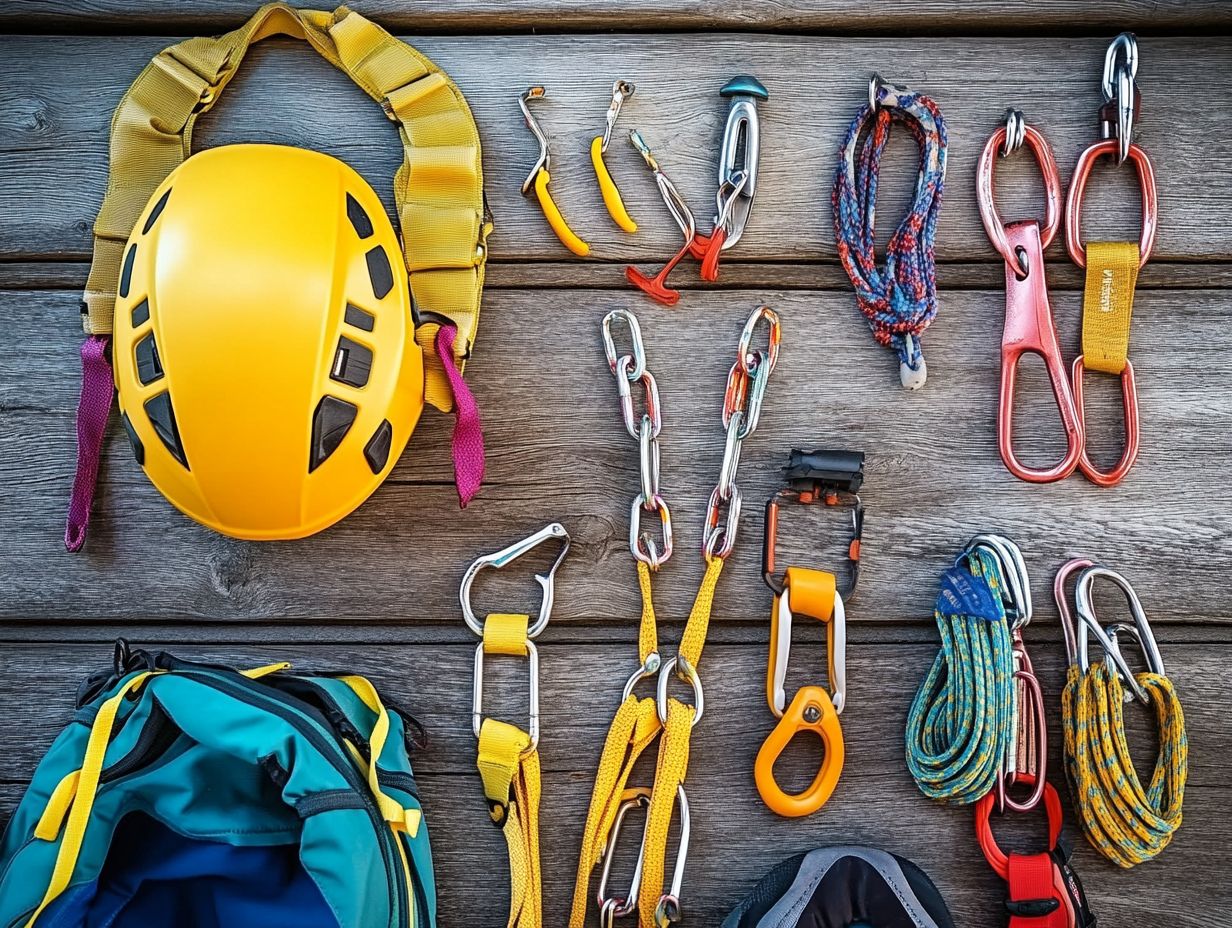
You need five key pieces of gear for rock climbing: a harness, climbing shoes, a chalk bag, a belay device, and a helmet. These items are vital for keeping you safe and performing well.
Why is a climbing harness important?
A climbing harness is important because it is the main piece of equipment that keeps you attached to the rope while climbing. It distributes your weight evenly and provides support and protection in case of a fall.
What kind of climbing shoes should I get?
There are different types of climbing shoes, but the most important factor is finding a comfortable and snug fit. The shoes should also have a good grip and provide support for your feet while climbing.
Do I really need a chalk bag for rock climbing?
Yes, a chalk bag is key for keeping your hands dry and improving your grip while climbing. It helps prevent the build-up of sweat and oils on your hands, which can cause you to slip off holds. Proper use of climbing chalk is crucial for climbing performance and ensures an enjoyable climbing experience.
What is the purpose of a belay device?
A belay device is used to manage the rope while belaying a climber. It helps control the speed of the rope and provides a brake in case the climber falls. Without a belay device, belaying would be much more difficult and dangerous. It is one of the essential climbing equipment items for safety and is vital for understanding climbing techniques.
Gear up and get climbing safely!
Why Do I Need a Helmet for Rock Climbing?
A helmet protects your head from rock falls and accidental tumbles while climbing. It also shields you from harsh weather and boosts your confidence as you climb.
Buying a good climbing helmet is essential for your safety. Make it a part of your climbing gear today!

